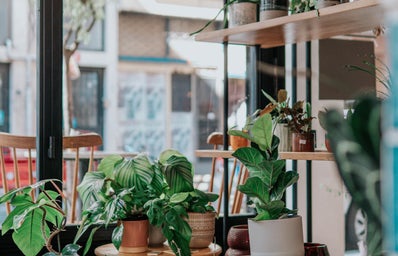Plants are a lot more maintenance than some might give them credit for. Growing up in a house with many plants and watching my parents care for them made it seem fairly simple, but starting my own plant maintenance was much more challenging than I thought. I have been taking care of plants for about four years now, and have had plants die on me to such a degree that it became a running joke in my house that you would be sending a plant out for slaughter if you gave it to me.
Some plants that are labeled as easy were not necessarily the ones that I found simple to care for. But, I’ve become more patient and understanding of how to maintain plants over the years, so I thought I would share some ideas of which plants to care for first if you’re new to the gig. A few tips that apply to all the plants I’ll be talking about here. Firstly, don’t be too eager about watering. These plants generally need to dry out between waterings and will rot if they’re too moist.
Secondly, try rotating plants a quarter-turn every month or so. This ensures that all sides get the same amount of sunlight, and it’ll help them grow more evenly. A good tell for when your plant is ready to be repotted is that you’ll see its roots poking through the holes at the base of its pot, or its growth will slow down. In any case, you might also notice it’s getting too big for its pot.
- Snake plants
-
Snake plants are typically very relaxed plants, despite their pointy appearance. They are typically found in tropical and subtropical areas, so I typically treat them like a desert plant. I have a Dracaena trifasciata, which is a variegated species of snake plant, and thus has dark green leaves with yellow borders. Baby shoots first grow in this bright light green, and they gradually darken over time as they get larger. I allow mine to dry out between waterings, and they don’t require much water in the first place. I typically water mine once every 10 days or so, or when a finger’s deep worth of their soil feels completely dry.
It’s especially important not to overwater in the winter because this is considered a dormant period for plants. Snake plants prefer indirect sunlight, so a room where sheer curtains or blinds are kept down, or a room that doesn’t face the sun at its high points, is nice for them. Temperatures for these plants should be somewhere between 16 and 24 degrees Celsius. My snake plant has actually proven to be pretty robust to different temperatures.
I recently moved out of my parents’ house, where its former residence in my bedroom was fairly cold, and it’s now in a room that gets quite a lot of indirect sun and warmth, and it’s done great in both areas. Generally, you should only be misting plants if you’ve looked into it and they definitely require it. Otherwise, I have found misting can lead to excessive moisture and isn’t super ideal. Because this plant’s leaves will generally grow from its middle, taking a damp washcloth to it will keep it from attracting dust or little house bugs looking for shelter.
- Pothos
-
I didn’t think my pothos would be this easy to care for, but maybe that’s because it was my “getting a hang of it” plant. Because it required a little more water than my previous desert plants needed, I had to restrain myself from too eagerly watering it. Mine is in my office, which gets lots of indirect “curtained” sunlight and warmth.
I find that the perfect amount of time between waterings usually falls somewhere within seven to nine days. Because this is a creeping plant, I give its pot a quarter-turn more often than that of the pothos, and I find it allows the plant to grow more symmetrically.
This plant likes higher humidity, but do make sure you’re not overcompensating with its watering. Typically, I fill the pot to its brim when the first quarter of its soil is dry, and top it off with a quarter-turn. These plants are gorgeous and can be strung around your furniture or up your walls as they grow.
Just make sure you’re not exposing it to drafty or cold areas, as these can affect its growth. I haven’t found misting to make a huge difference for these plants, and I think it could lead to rot, so if its leaves get dusty, just take a damp washcloth to them carefully.
- Cacti (not succulents)!
-
So, I have kind of an aversion to succulents, despite how aesthetically pleasing and soft they are. They were some of my first plants because I thought they’d be easy, but they ended up dying from how much attention I gave them. I still haven’t gone back to them, because I’m finding cacti are a better bet. Cacti are known to thrive on neglect, and I really didn’t take that seriously until recently. One year, my brother and I got our own cacti as gifts, and despite being the one who toted most over their plant while he barely paid his any mind, mine died long before his.
So, note to the wise: don’t be a helicopter parent to your cactus! In my experience, if this plant looks thirsty, it’s actually doing alright. I give mine a bit of water, maybe to the brim of its pot every 10-20 days, and it’s been doing fine. Cacti like bright places, but aim for indirect light, as direct sunlight can be hurtful to them. Misting this plant also won’t be helpful as it tends to do best when it’s dry.
- Peace lilies
-
This plant is one of my favorites because it flowers! It’s also super dramatic when it’s thirsty, which can be a useful tell if you’re unsure when it needs to be watered. Its leaves will droop, and nearly immediately after you water it, it’ll perk right back up again. It’s perfect for places with lower light (I have mine in a fairly dark corner near a window), and it does okay. This is a plant that wouldn’t mind a light mist now and then.
You can pair this with a light wipe with a washcloth, and it’ll keep the leaves shiny. This plant will do well in a more humid area, so try the bathroom or the kitchen.
- ZZ plants
-
From my experience, your problem with this plant is that it will not stop growing! This plant likes lots of indirect light and seems to even do well with fluorescent light. My ZZ plant is in my corporate office setting, with lots of natural indirect light but also lots of office lighting, and it just keeps going! Its appearance reminds me of a jade plant, but it’s hardier, with dark, shiny raindrop-shaped leaves, and usually grows straight up.
You can use tie-wraps or a loosely tied piece of rope to direct its growth, if you want it to be more vertical than outward. This plant, in my experience, grows very quickly if you’ve found its sweet spot, and you might need to prepare for repotting very shortly after it settles in.
Remember that plant care requires practice and patience. It’s typical to begin by being a little too eager to water or interact with your plants, but letting them do their own thing is sometimes the best way to learn about them. There are countless resources available online or otherwise if you have concerns, and I have learned so much of what I know just by googling and trying different things.
Hoping this helps forward your plant parentship. Happy planting!





